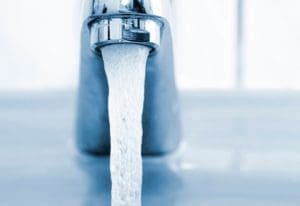Author: Jack Springston, CIH, CSP, FAIHA,
Industrial Hygiene Services Manager and Training Director at Atlas
Building water systems are critical and necessary to all building operations. As schools begin to reopen, and companies and employees return to the workplace, employers must take steps to ensure that the water in their buildings is safe for occupants. The potential for lead to leach into water can increase the longer the water remains in contact with lead in plumbing. As a result, buildings that have remained essentially closed for months due to the COVID-19 pandemic, and those with intermittent water use patterns, such as schools, may have elevated lead concentrations.
Additionally, water that sits stagnant for an extended time in water mains, premise plumbing, and water heaters loses residual chlorine disinfectant, leading to an increased risk of bacterial colonization, including Legionella. Building operators cannot assume that municipal water suppliers effectively disinfect and flush the lines, or address bacterial growth that occurs in the building’s plumbing. The standard of care for managing waterborne pathogens has shifted to building owners and operators. After reoccupying buildings that have been largely closed and unoccupied for weeks and months, the risk of suffering an outbreak of Legionnaires’ disease is very real. It falls upon the owners and operators to assess and manage these risks, and implement preventative and remedial measures, if needed.
Water testing for lead and Legionella bacteria helps evaluate plumbing systems and outlets so that, if necessary, targeted remediation efforts can be taken. Such testing is a key step in understanding if there is a problem and, if so, in designing an appropriate response.
 WHAT IS FLUSHING?
WHAT IS FLUSHING?
Simply put, “flushing” involves turning on faucets and opening taps to flush out the stagnant water that has been standing in the building’s pipes and outlets and replace it with “fresh” water. The flushing time can vary by the type of outlet being cleared, as well as how far away the outlet is from the water main entering the building. The degree to which flushing can reduce lead levels will vary depending upon the age and condition of the plumbing, as well as the corrosiveness (i.e., pH) of the water. Similarly, the degree to which flushing can lower and control bacteria and biofilms depends on the type and levels of disinfectant in the supply water to the building. Flushing can be an effective tool to control lead and waterborne pathogens exposures, but only when used appropriately.
FLUSHING TO IMPROVE WATER QUALITY
In schools, office buildings, and other facilities, establishing a periodic, ongoing flushing program is one of the easiest ways to ensure that the water quality in the building is preserved by decreasing water age. Flushing does not require installation or maintenance of supplemental water treatment equipment, and the associated costs. Flushing should be used as a regular practice to ensure the water is regularly replaced in the system and residual disinfectant levels are sufficient to control microbial growth.
FLUSHING AND SAMPLING FOR LEAD
When sampling for lead, it is important that the sample is representative of the water that is being consumed. For this reason, the U.S. Environmental Protection Agency (EPA) does not recommend that schools collect samples first thing in the morning after weekends, holidays, or vacations/breaks because the water will have remained stagnant for too long and would not be typical of the water used for drinking during the normal school day. Accordingly, drinking water outlets should be flushed after such breaks to maintain water quality.
The EPA does not recommend flushing for the sole purpose of sampling, but rather as a regular standard practice to ensure the building water does not stagnate. Flushing outlets immediately before sampling may lead to lead results that are lower than the actual representative levels in the water. Flushing is only appropriate when conducting follow-up flush sampling or sequential sampling to identify potential lead concerns in the interior plumbing.
FLUSHING AND SAMPLING FOR LEGIONELLA
When performing routine sampling for Legionella, first draw samples are preferred and represents the water conditions at the tap and the immediate piping. Use flush samples for monitoring water sources, such as storage tanks (cold or hot) and centralized or non-centralize hot water heaters. A flush water sample represents the water conditions in the piping upstream of the tap, in the riser, in a circulated loop, or in a pipe header.
FLUSHING AND REMEDIATION FOR LEAD
Routine flushing can be a quick and easy solution to elevated lead levels, especially when contamination is localized in a certain area of the building or in a small building. Flushing can be used as a short-term solution, while solutions that are more permanent are being developed and implemented.
An important consideration when utilizing flushing for remediation is the frequency that flushing needs to occur (e.g., daily, twice weekly, etc.), the labor requirements to perform such flushing, and whether it is even feasible to do at your particular facility. Depending upon the age and condition of the plumbing, and the corrosiveness of the water, elevated lead levels can return relatively quickly following flushing. Unless you can ensure lead levels remain low throughout the day, it is not recommended to flush only once a day or once a week as a solution to high lead levels. Flushing for one or two minutes, immediately prior to use, may be a short-term solution, in conjunction with signage and schedules.
Make sure to periodically collect samples after implementing a flushing-for-remediation program to verify that the water being provided does not contain elevated lead levels.
FLUSHING AND REMEDIATION FOR LEGIONELLA
While routine flushing can help to ensure that residual disinfectant levels are maintained within the plumbing system, to help control bacteria growth, such flushing is typically inadequate to remediate a system once it has become contaminated. Building water control strategies for waterborne pathogens, such as Legionella, should include routine water sampling for culturable Legionella, routine flushing and water sampling for free residual disinfectant levels and water temperature, and periodic cleaning and disinfecting of aerator devices and shower heads.

TIPS FOR DEVELOPING A FLUSHING PLAN
When developing a flushing program as a regular practice, or as a short-term remediation effort for lead:
- Determine how and where the municipal water enters the building and flows through your facility, and create a flow diagram;
- Locate all water outlets that are used for consumption purposes or where aerosols may be generated and released into the air;
- Utilize signage to indicate when, and for how long, flushing needs to occur at each outlet;
- Create a water management program team to develop, implement, and document the program, and
- Develop a testing program to verify and validate the effectiveness of any control measures put into place.
